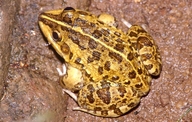|
Description
A large frog with snout-vent lengths of males: 60-90 mm and females: 70-135 mm. The dorsal color is olive or yellow with dark brown to black spots. Ventral color is white to yellowish. A yellow vertebral stripe is prominent in some individuals. This species looks very similar to Hoplobatrachus tigerinus. Distribution and Habitat
Country distribution from AmphibiaWeb's database: Bangladesh, India, Nepal, Sri Lanka
Terra Typica: Carnatic, India
H. crassus is found in Sri Lanka (the largest frog in the Island), southeastern India, Uttar Pradesh, Nepal. H. crassus is semiaquatic, common along rivers, reservoirs and marshes. In Sri Lanka the author found specimens in towns next to human settlement. H. crassus is found up to 460 m asl. In Sri Lanka both in the wet and the dry zone of the country.
Life History, Abundance, Activity, and Special Behaviors
H. crassus is active at night, looking for food. H. crassus can often be seen after heavy rains, when mating begins. The males call from watersides. The tadpoles are very aggressive towards other tadpoles. The author once placed two tadpoles of H. crassus together with tadpoles from several other species (Euphlyctis cyanophlytis, Kaloula taprobanica). After a few days, the other species had been eaten by the H. crassus larvae. One was seen killing a tadpole of K. taprobanica. It is quite similar to Hoplobatrachus species in Africa (Lötters pers. comm.). Possible reasons for amphibian decline Local pesticides, fertilizers, and pollutants
Long-distance pesticides, toxins, and pollutants
Comments
H. crassus is often confused with H. tigerinus, including historically. It is unclear if H. tigerinus is really a Sri Lankan species. Records of Hoplobatrachus tigerinus from Sri Lanka are considered to be misidentified specimens of Hoplobatrachus crassus (Batuwita et al. 2019).
References
Batuwita S, Udugampala S, DeSilva M, Diao J and Edirisinghe U. (2019). "A review of amphibian fauna of Sri Lanka: distribution, recent taxonomic changes and conservation." Journal of Animal Diversity, 1(2), 44-82. [link]
Dutta, S.K. and Manamendra-Arachchi, K. (1996). The Amphibian Fauna of Sri Lanka. Wildlife Heritage Trust of Sri Lanka, Colombo, Sri Lanka.
Manamendra-Arachchi, K. (2000). ''Know your frog.'' Sri Lanka Nature, 2(5), 4-16.
Originally submitted by: Peter Janzen (first posted 2005-05-01)
Edited by: Tate Tunstall, Michelle S. Koo (2021-05-09)Species Account Citation: AmphibiaWeb 2021 Hoplobatrachus crassus: Jerdon`s Bullfrog <https://amphibiaweb.org/species/4711> University of California, Berkeley, CA, USA. Accessed May 14, 2025.
Feedback or comments about this page.
Citation: AmphibiaWeb. 2025. <https://amphibiaweb.org> University of California, Berkeley, CA, USA. Accessed 14 May 2025.
AmphibiaWeb's policy on data use.
|
